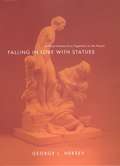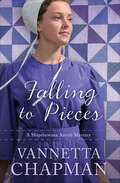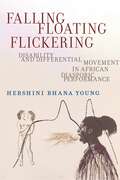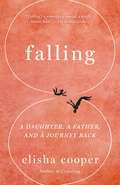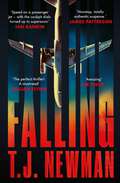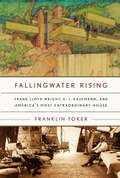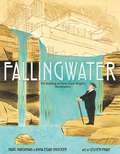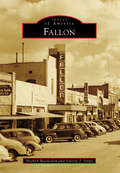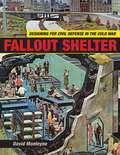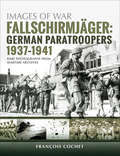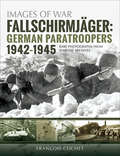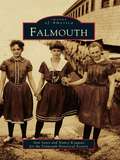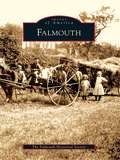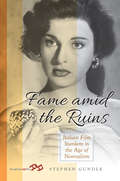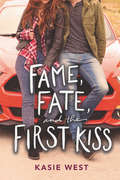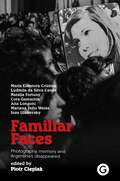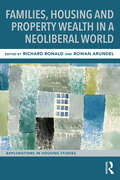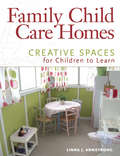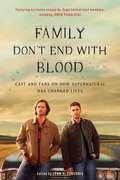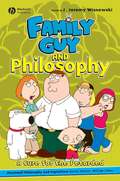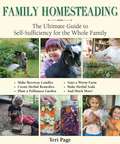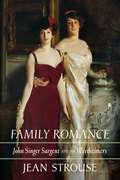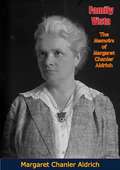- Table View
- List View
Falling in Love with Statues: Artificial Humans from Pygmalion to the Present
by George L. HerseyHersey reveals what has been an instrumental practice since antiquity in our efforts to understand, improve, and empower ourselves. Hersey's history of statue love begins in Cyprus, home of the legendary sculptor Pygmalion, who famously grew enamored of his own creation.
Falling to Pieces: A Quilt Shop Murder (The Shipshewana Amish Mysteries #1)
by Vannetta ChapmanIn this mystery by a USA Today bestseller, a Houston woman inherits an Amish country quilt shop in Indiana where she finds herself suspected of murder. When two women—one Amish, one English—each with different motives, join forces to organize a successful on-line quilt auction, neither expects nor wants a friendship. As different as night and day, Deborah and Callie are uneasy partners who simply want to make the best of a temporary situation. But a murder, a surprising prime suspect, a stubborn detective, and the town&’s reaction throw the two women together, and they form an unlikely alliance to solve a mystery and catch a killer.2012 Carol Award Winner for Best Mystery 2012 Southern Magic Best Inspirational Single Title
Falling, Floating, Flickering: Disability and Differential Movement in African Diasporic Performance (Crip #7)
by Hershini Bhana YoungInsists on the importance of embodiment and movement to the creation of Black socialityLinking African diasporic performance, disability studies, and movement studies, Falling, Floating, Flickering approaches disability transnationally by centering Black, African, and diasporic experiences. By eschewing capital’s weighted calculus of which bodies hold value, this book centers alternate morphologies and movement practices that have previously been dismissed as abnormal or unrecognizable. To move beyond binaries of ability, Hershini Bhana Young traverses multiple geohistories and cultural forms stretching from the United States and the Mediterranean to Sierra Leone, Nigeria, and South Africa, as well as independent and experimental film, novels, sculptures, images, dance, performances, and anecdotes. In doing so, she argues for the importance of differential embodiment and movement to the creation and survival of Black sociality, and refutes stereotypic notions of Africa as less progressive than the West in recognizing the rights of disabled people. Ultimately, this book foregrounds the engagement of diasporic Africans, who are still reeling from the violence of colonialism, slavery, poverty, and war, as they gesture toward a liberatory Black sociality by falling, floating, and flickering.
Falling: A Daughter, a Father, and a Journey Back
by Elisha CooperElisha Cooper spends his mornings creating children's books and his afternoons playing with his two daughters. But when he discovers a lump in five-year-old Zoë's midsection as she sits on his lap at a Chicago Cubs game, everything changes. Surgery, sleepless nights, months of treatment, a drumbeat of worry. Even as the family moves to New York and Zoë starts kindergarten, they must navigate a new normal: school and soccer and hot chocolate at the local café, interrupted by anxious visits to the hospital. Elisha and his wife strive to help their daughters maintain a sense of stability and joy in their family life. And he tries to understand this new world--how it changes art and language and laughter--as he holds on to the protective love he feels for his child. With the observant eye of an artist and a remarkable sense of humor, Elisha captures his family's journey through a perilous time and, in the process, shows how we are all transformed by the fear and hope we feel for those we loveFrom the Hardcover edition.
Falling: the most thrilling blockbuster read of the summer
by T. J. NewmanPRE-ORDER THE PAPERBACK EDITION OF DROWNING, THE THRILLING NEW BLOCKBUSTER BY T. J. NEWMAN. OUT JUNE 2024. &‘Amazing . . . Intense suspense, shocks and scares plus chilling insider authenticity make this one very special&’ LEE CHILD 'FALLING is the best kind of thriller (for me as a reader anyway). Characters you care deeply about. Nonstop, totally authentic suspense' JAMES PATTERSON&‘Attention, please: T. J. Newman has written the perfect thriller! GILLIAN FLYNN, #1 bestselling author of Gone GirlYou just boarded a flight to New York.There are one hundred and forty-three other passengers onboard.What you don&’t know is that thirty minutes before the flight your pilot&’s family was kidnapped.For his family to live, everyone on your plane must die.The only way the family will survive is if the pilot follows his orders and crashes the plane. Enjoy the flight. ***Praise for Falling*** &‘Think Speed on a passenger jet - with the cockpit dials turned up to supersonic&’ Ian Rankin &‘Stunning and relentless. This is Jaws at 35,000 feet&’ Don Winslow &‘The best thriller I&’ve read in years. Buckle up&’ Adrian McKinty &‘Attention, please: T. J. Newman has written the perfect thriller! ... Terrific and terrifying, a true page-turner.. A must-read for summer vacation' Gillian Flynn, #1 bestselling author of Gone Girl &‘A jet-propelled thriller that will have you in its grip from first page to last. A truly astonishing debut and an incredible work of pure suspense&’ Steve Cavanagh 'Newman keeps up an extreme pace from the first page—a near-impossible task, considering that the hero is locked in a cockpit, unable to take action himself. This novel is like the films Die Hard and Speed on steroids, creating one of the year&’s best thrillers' Library Journal &‘With characters you&’ll root for and a plot that dips and bounces like a plane hitting turbulence, this thrill ride is impossible to put down&’ Daily Mail &‘A scorching thriller&’ Evening Standard 'Newman&’s [flight attendant] background means Falling brings a freshness and depth to the genre' The Guardian 'A superlative debut . . . This tense, convincing thriller marks the arrival of an assured new talent' Publishers Weekly ' ...full of the kind of authentic detail that comes from personal experience' Literary Review &‘Gripping from the first sentence, this thriller is like no other&’ OK! Magazine 'A remarkable debut' The Sunday Times '... a tense and claustrophobic read, the fast-paced action zipping along at an astonishing rate' Refinery29
Fallingwater Rising: Frank Lloyd Wright, E. J. Kaufmann, and America's Most Extraordinary House
by Franklin TokerFallingwater Rising is a biography not of a person but of the most famous house of the twentieth century. Scholars and the public have long extolled the house that Frank Lloyd Wright perched over a Pennsylvania waterfall in 1937, but the full story has never been told. When he got the commission to design the house, Wright was nearing seventy, his youth and his early fame long gone. It was the Depression, and Wright had no work in sight. Into his orbit stepped Edgar J. Kaufmann, a Pittsburgh department-store mogul--"the smartest retailer in America"--and a philanthropist with the burning ambition to build a world-famous work of architecture. It was an unlikely collaboration: the Jewish merchant who had little concern for modern architecture and the brilliant modernist who was leery of Jews. But the two men collaborated to produce an extraordinary building of lasting architectural significance that brought international fame to them both and confirmed Wright's position as the greatest architect of the twentieth century. Fallingwater Rising is also an enthralling family drama, involving Kaufmann, his beautiful cousin/wife, Liliane, and their son, Edgar Jr., whose own role in the creation of Fallingwater and its ongoing reputation is central to the story. Involving such key figures of the l930s as Frida Kahlo, Albert Einstein, Henry R. Luce, William Randolph Hearst, Ayn Rand, and Franklin Roosevelt, Fallingwater Rising shows us how E. J. Kaufmann's house became not just Wright's masterpiece but a fundamental icon of American life. One of the pleasures of the book is its rich evocation of the upper-crust society of Pittsburgh--Carnegie, Frick, the Mellons--a society that was socially reactionary but luxury-loving and baronial in its tastes, hobbies, and sexual attitudes (Kaufmann had so many mistresses that his store issued them distinctive charge plates they could use without paying). Franklin Toker has been studying Fallingwater for eighteen years. No one but he could have given us this compelling saga of the most famous private house in the world and the dramatic personal story of the fascinating people who made and used it. A major contribution to both architectural and social history.
Fallingwater: The Building of Frank Lloyd Wright's Masterpiece
by Marc Harshman Anna Egan SmuckerIn Bear Run, Pennsylvania, a home unlike any other perches atop a waterfall. The water's tune plays differently in each of its sunlight-dappled rooms; the structure itself blends effortlessly into the rock and forest behind it. This is Fallingwater, a masterpiece equally informed by meticulous research and unbounded imagination, designed by the lauded American architect Frank Lloyd Wright. This book guides young readers through Wright's process designing Fallingwater, from his initial inspirations to the home's breathtaking culmination. It is a exploration of a man, of dreams, and of the creative process; a celebration of potential. Graceful prose and rich, dynamic illustrations breathe life into the story of Frank and Fallingwater, a man and home utterly unlike any other.A Bulletin of the Center for Children's Books 2017 Blue Ribbon BookA National Council for the Social Studies Notable Social Studies Trade Book for Young People
Fallon (Images of America)
by Valerie Serpa Michon MackedonIn the mid- to late 19th century, nonnative populations first settled Fallon, Nevada, and the surrounding areas in Churchill County. Tracts of land were claimed from a desert floor, watered sporadically by the Carson River, which, in "good years," flows abundantly through the region. Fallon can be seen as a palimpsest, having once exclusively been home to Native Americans and then becoming an overland crossroads. In the mid-1890s, Jim Richards established a store at the crossing and Mike Fallon opened a small post office nearby. Now referred to as the "Oasis of Nevada," it is home to thousands. Lahontan Dam, completed in 1915, strengthened early agricultural roots and inspired rural dreams of verdant plenitude. Churchill County presently supports dairies and vineyards as well as farms and ranches. The city of Fallon has developed in significant ways, taking pride in its cultural life, schools, parks, businesses, and city-owned utility enterprises.
Fallout Shelter: Designing for Civil Defense in the Cold War (Architecture, Landscape and Amer Culture)
by David MonteyneIn 1961, reacting to U.S. government plans to survey, design, and build fallout shelters, the president of the American Institute of Architects, Philip Will, told the organization&’s members that &“all practicing architects should prepare themselves to render this vital service to the nation and to their clients.&” In an era of nuclear weapons, he argued, architectural expertise could &“preserve us from decimation.&”In Fallout Shelter, David Monteyne traces the partnership that developed between architects and civil defense authorities during the 1950s and 1960s. Officials in the federal government tasked with protecting American citizens and communities in the event of a nuclear attack relied on architects and urban planners to demonstrate the importance and efficacy of both purpose-built and ad hoc fallout shelters. For architects who participated in this federal effort, their involvement in the national security apparatus granted them expert status in the Cold War. Neither the civil defense bureaucracy nor the architectural profession was monolithic, however, and Monteyne shows that architecture for civil defense was a contested and often inconsistent project, reflecting specific assumptions about race, gender, class, and power.Despite official rhetoric, civil defense planning in the United States was, ultimately, a failure due to a lack of federal funding, contradictions and ambiguities in fallout shelter design, and growing resistance to its political and cultural implications. Yet the partnership between architecture and civil defense, Monteyne argues, helped guide professional design practice and influenced the perception and use of urban and suburban spaces. One result was a much-maligned bunker architecture, which was not so much a particular style as a philosophy of building and urbanism that shifted focus from nuclear annihilation to urban unrest.
Fallschirmjäger: German Paratroopers, 1937-1941 (Images of War #19)
by François Cochet&“[An] excellent volume . . . The training and uniforms of this elite fighting force are well-covered, as are descriptions of the battles fought.&” —Army Rumour Service As elite troops, the German Fallschirmjäger (paratroopers) were regularly engaged in front line combat during the Second World War. Their famed actions such as the fighting in Scandinavia, the taking of the Belgian fortress Eden-Emal in May 1940, and the Battle for Crete just a year later, have given them the reputation of being determined, courageous and loyal soldiers. This book covers the early years of the Fallschirmstruppen (paratroop units) before the beginning of the war, until the height of their successes in 1941, after which the Fallschirmjäger were more often deployed in a more &“traditional&” way, even though high-risk actions (such as at Monte Cassino, the Gran Sasso Raid) allowed them to reconnect once more with their glorious past. &“The very popular Images of War series has established a format with a large number of rare photographs in each book and clear concise text supporting the photographic selection. This new addition follows the proven format to provide a graphic history and analysis of German paratroopers in WWII. Highly Recommended.&” —Firetrench &“Model figure hobbyists and diorama builders can find lots of visual inspirations for future projects.&” —Toy Soldier & Model Figure
Fallschirmjäger: German Paratroopers, 1942-1945 (Images of War)
by François CochetThe second volume following the World War II exploits of the famed German parachute unit—from the battle of Crete to the surrender of the Third Reich. As elite troops, the German Fallschirmjäger (paratroopers) were regularly engaged in front line combat during the Second World War. Their famed actions such as the fighting in Scandinavia, the taking of the Belgian fortress Eden-Emal in May 1940, and the Battle for Crete just a year later, have given them the reputation of being determined, courageous and loyal soldiers. This book continues the pictorial history of the Fallschirmjäger, focusing on the period following the bloody Battle for Crete. Used as elite infantry, first in the USSR and then in Africa, the Fallschirmjäger were able to reconnect with their glorious past, whether in Italy or on the Greek Islands, as they jumped from their Ju 52s to engage the enemy. Their hard fighting in Italy helped to cement the legend of &“the Green Devils,&” with the British General Harold Alexander describing them as &“tenacious, highly trained men, hardened by their many actions and combats.&” However, during the fighting in Normandy, the Ardennes and on the Eastern Front, the number of veterans decreased, meaning it was the young German paratroopers who finally surrendered the Third Reich on 8 May 1945. &“François Cochet&’s two-volumes in the Images of War series are not only an excellent introduction to this force and its combat history in the war, but also much, much more.&” —Avon Napoleonic Fellowship
Falmouth (Images of America)
by Nancy Kougeas Falmouth Historical Society Ann SearsFor hundreds of years, people have been drawn to Falmouth, the town of the "shining sea," immortalized by Falmouth native Katherine Lee Bates in her poem America, the Beautiful. Quakers, farmers, whaling captains, marine scientists, Coast Guardsmen, summer residents, Portuguese immigrants from the Azores and Cape Verde Islands, vacationers, and retiring World War II veterans have all found a special place in Falmouth. The photographs in Falmouth celebrate these people and the town they have built. Through the eyes of nearly fifty photographers, these views capture the glorious natural and architectural heritage that has defined the three-hundred-and-forty-year history of this Cape Cod community. From the spare lines of the Quaker meetinghouse and the poorhouse to the spires of churches and the elaborate summer "cottages" of Falmouth's golden age in the 1880s, these vintage photographs offer a rich visual tour through the town's history. Unforgettable images of people-whalers posing for the camera on rare trips home, fishermen returning to port, cranberry pickers, and wealthy summer residents playing croquet in summer whites-combine to show the unique community that is Falmouth.
Falmouth (Images of America)
by The Falmouth Historical SocietyFalmouth began as a farming and fishing town with an active wooden ship-building industry along the Presumpscot River Estuary. The town later developed a number of small villages, each with a post office, stores, and its own school. Following the Civil War, the population dropped and did not begin to increase until the beginning of World War II. Wealthy Portland residents and out-of-state visitors established summer estates in Falmouth Foreside. With the introduction of the automobile and the electric trolley in the early 1900s, the Falmouth Foreside and West Falmouth areas enjoyed an influx of people who could live in Falmouth and work in Portland. After World War II, Falmouth continued to increase in size as roads were improved and more houses were built. Today Falmouth remains a growing community with extensive retail, health, retirement, and service facilities.
Fame Amid the Ruins: Italian Film Stardom in the Age of Neorealism
by Stephen GundleItalian cinema gave rise to a number of the best-known films of the postwar years, from Rome Open City to Bicycle Thieves. Although some neorealist film-makers would have preferred to abolish stars altogether, the public adored them and producers needed their help in relaunching the national film industry. This book explores the many conflicts that arose in Italy between 1945 and 1953 over stars and stardom, offering intimate studies of the careers of both well-known and less familiar figures, shedding new light on the close relationship forged between cinema and society during a time of political transition and shifting national identities.
Fame Amid the Ruins: Italian Film Stardom in the Age of Neorealism
by Stephen GundleItalian cinema gave rise to a number of the best-known films of the postwar years, from Rome Open City to Bicycle Thieves. Although some neorealist film-makers would have preferred to abolish stars altogether, the public adored them and producers needed their help in relaunching the national film industry. This book explores the many conflicts that arose in Italy between 1945 and 1953 over stars and stardom, offering intimate studies of the careers of both well-known and less familiar figures, shedding new light on the close relationship forged between cinema and society during a time of political transition and shifting national identities.
Fame, Fate, and the First Kiss
by Kasie WestFan favorite author Kasie West delivers an effervescent story about chasing your dreams and following your heart, perfect for fans of Jenny Han and Huntley Fitzpatrick. Lacey Barnes has dreamed of being an actress for as long as she can remember. So when she gets the opportunity to star in a movie alongside one of Hollywood’s hottest actors, she doesn’t hesitate to accept the part.But Lacey quickly learns that life in the spotlight isn’t as picture perfect as she imagined. She’s having trouble bonding with her costars, her father has hired the definition of a choir boy, Donavan Lake, to tutor her, and somewhere along the way she’s lost her acting mojo. And just when it seems like things couldn’t get any worse, it looks like someone on set is deliberately trying to sabotage her. As Lacey’s world spins out of control, it feels like the only person she can count on—whether it’s helping her try to unravel the mystery of who is out to get her or snap her out of her acting funk—is Donavan. But what she doesn’t count on is this straight-laced boy becoming another distraction.With her entire future riding on this movie, Lacey knows she can’t afford to get sidetracked by a crush. But for the first time in her life Lacey wonders if it’s true that the best stories really do happen when you go off script.
Familiar Faces: Photography, Memory, and Argentina’s Disappeared
by Piotr CieplakAn exploration of the rich and varied relationship between photography and the most recent Argentine dictatorship.Familiar Faces offers a diverse, theoretically rich, and empirically informed exploration of photography in Argentina&’s memorial, political, and artistic landscape. During the country&’s most recent civic-military dictatorship (1976–1983), 30,000 people were disappeared or killed by the state. Over the decades, vernacular and professional photographs have been central to the Argentine struggle for justice. They were used not only to protest the disappearances under the dictatorship and to denounce the authorities, but also as tools of political and social activism, and for remembering the disappeared.With contributions from leading Argentina-based anthropologists, ethnographers, curators, art scholars, media researchers, and photographers, Familiar Faces moves beyond the traditional considerations of representation, focusing instead on the ways in which photography is continuously reimagined as a tool of memory, mourning, and political and judicial activism. In so doing, it considers the diverse uses of press photography; artistic practice; photographs of the disappeared in domestic rituals; photographs of the inmates of torture centers; the reclamation of images taken by the dictatorial state for memorial and activist purposes. Written and published at a crucial moment in Argentine memory politics, Familiar Faces offers a geographically and formally diverse selection of case studies, with international as well as regional resonance. While firmly rooted in this national context, the book contributes to wider, global debates about the increasingly pervasive role of the photographic image in relation to state-sponsored, large-scale violence.
Families, Housing and Property Wealth in a Neoliberal World (Explorations in Housing Studies)
by Richard Ronald Rowan ArundelThe twenty-first century has so far been characterized by ongoing realignments in the organization of the economy around housing and real estate. Markets have boomed and bust and boomed again with residential property increasingly a focus of wealth accumulation practices. While analyses have largely focussed on global flows of capital and large institutions, families have served as critical actors. Housing properties are family goods that shape how members interact, organise themselves, and deal with the vicissitudes of everyday economic life. Families have, moreover, increasingly mobilized around their homes as assets, aligning household transitions and practices towards the accumulation of property wealth. The capacities of different families to realise this, however, are highly uneven with housing conditions becoming increasingly central to growing inequalities and processes of social stratification. This book addresses changing relationships between families and their homes over the latest period of neo-liberalization. The book confronts how transformations in households, life-course transitions, kinship and intergenerational relations shape, and are being shaped by, the shifting role of property markets in social and economic processes. The chapters explore this in terms of different aspects of home, family life and socioeconomic change across varied national contexts.
Family Child Care Homes
by Linda J. ArmstrongCreate a warm and inviting place where children feel at home.Discover the many ways your home can provide comfortable places where children love to learn and love to be. Filled with no- and low-cost ideas, this book demonstrates many unique and practical possibilities for your home's indoor and outdoor spaces. Chapters are packed with colorful photographs and provide examples and tips for designing learning zones, selecting items, organizing materials, and more. Checklists, resources, and questions are included to help you evaluate your setting, implement changes, and create a place that feels like a second home to the children in your care.
Family Don't End with Blood: Cast and Fans on How Supernatural Has Changed Lives
by Lynn S. ZubernisHow a Show, and the Support of Its Fandom, Changed—and Saved—Lives Supernatural, a three-time People's Choice Award winner for Favorite Sci-Fi/Fantasy TV Show and Tumblr's 2015 Most Reblogged "Live Action TV," has made a name for itself by supporting and encouraging its fans to "always keep fighting," and a memorable line from early in the show's run, "Family don't end with blood," became an inspiring mantra for many who found community in the fandom. In 25 powerful chapters written by Supernatural's actors and fans, including series lead Jared Padalecki, plus special messages from Jensen Ackles, Misha Collins, and Mark Sheppard, Family Don't End with Blood: Cast and Fans On How Supernatural Has Changed Lives examines the far reach of the show's impact for more than a decade. Supernatural has inspired fans to change their lives, from getting "sober for Sam" to escaping a cult to pursuing life-long dreams. But fans aren't the only ones who have been changed. The actors who bring the show to life have also found, in the show and its community, inspiration, courage, and the strength to keep going when life seemed too hard. Including essays and special messages from Supernatural 's cast: Jared Padelecki ("Sam Winchester") Jensen Ackles ("Dean Winchester") Misha Collins ("Castiel") Mark Sheppard ("Crowley") Jim Beaver ("Bobby Singer") Ruth Connell ("Rowena MacLeod") Osric Chau ("Kevin Tran") Rob Benedict ("Chuck Shurley aka God") Kim Rhodes ("Sheriff Jody Mills") Briana Buckmaster ("Sheriff Donna Hanscum") Matt Cohen ("Young John Winchester") Gil McKinney ("Henry Winchester") Rachel Miner ("Meg Masters") Collected and edited by Lynn S. Zubernis, a clinical psychologist, professor, and passionate Supernatural fangirl, Family Don't End with Blood provides an insightful and often uplifting look into the way international fan communities become powerful, positive forces in the lives of so many. In keeping with the show's message to "always keep fighting," a portion of the proceeds from the book will be donated to RANDOM ACTS, a nonprofit founded by Misha Collins, and AT TITUDES IN REVERSE, whose mission is to educate young people about mental health and suicide prevention.
Family Guy and Philosophy: A Cure for the Retarded
by J. Jeremy WisnewskiWisnewski (philosophy, Hartwick College) provides the analysis and some of the funny footnotes as he and his contributors work through postmodernism, religion and religious exclusivity, virtue and perversity, clueless men (in the character's case this is an oxymoron), motherhood, deadly sins, the importance of background people, dogs with personality, the logic of expectation, humor, fallacies, plagiarism, will and wantonness in wives, ego, and death. The result is fun, if you are a fan of the show, but even if you are not, you can get the point and most of the jokes.
Family Handyman Do-It-Yourself Basics Volume 2: Save Money, Solve Problems, Improve Your Home
by Family HandymanYou Can Do This! Save Thousands! Tackle the Easy Fixes Yourself Over 120 Step-by-Step Secrets Revealed The Basics Everyone Can MasterExcited to learn how to repair and improve your home yourself? Whether you own or rent, live in one room or 10, there are countless ways you can make your space better. With basic tools and skills, you’ll save money as you gain confidence in your DIY know-how.
Family Homesteading: The Ultimate Guide to Self-Sufficiency for the Whole Family
by Teri PagePractical advice and hands-on projects for the self-sufficient family In an increasingly digital world, families are looking for ways to deepen their connection to one another and to the land. The Family Homestead is a guide to a simpler life, one that integrates children into the daily work of creating a sustainable homestead. From gardening and cooking, to herbalism and natural crafts, The Family Homestead shares stories and hands-on projects that will deepen relationships and build self-sufficiency skills. Teri Page, author of the popular Homestead Honey blog, moved with her husband across country with young children to build their off-the-grid homestead on raw land. Together, they garden, forage, preserve foods, raise chickens, homeschool, and so much more. Perfect for homeschooling families or anyone working with or raising kids, readers will learn how to involve children in dozens of homesteading projects. Learn how to: Dye cloth with plant-based dyesMake beeswax candles Construct a rain barrel Hatch chicks Create a worm farm Grow giant pumpkins Make butter in a mason jar Make homemade herbal soda And so much more!
Family Romance: John Singer Sargent and the Wertheimers
by Jean StrouseJean Strouse captures the dramas, mysteries, intrigues, and tragedies surrounding John Singer Sargent's portraits of the Wertheimer family.Jean Strouse’s Family Romance: John Singer Sargent and the Wertheimers looks at twelve portraits of one English family painted by the expatriate American artist at the height of his career—and at the intersections of all these lives with the sparkle and strife of the Edwardian age.In commissioning this grand series of paintings, Asher Wertheimer, an eminent London art dealer of German-Jewish descent, became Sargent’s greatest private patron and close friend. The Wertheimers worked with Rothschilds and royals, plutocrats and dukes—as did Sargent. Asher left most of his Sargent portraits to the National Gallery in London, a gift that elicited censure as well as praise: it was a new thing for a family of Jews to appear alongside the Anglo-Saxon aristocrats and dignitaries painted by earlier masters.Strouse’s account, set primarily in England around the turn of the twentieth century, takes in the declining fortunes of the British aristocracy and the dramatic rise of new power and wealth on both sides of the Atlantic. It travels back through hundreds of years to the Habsburg court in Vienna and forward to fascist Italy in the 1930s. Its depictions of Sargent, his sitters, their friendships and circles, and the portraits themselves light up a period that saw tumultuous social change and the birth of the modern art market.Sargent brilliantly portrayed these transformations, in which the Wertheimers were key players. Family Romance brings their interwoven stories fully to life for the first time.
Family Vista: The Memoirs of Margaret Chanler Aldrich
by Margaret Chanler AldrichFirst published in 1958, these are the memoirs of Margaret Chanler Aldrich, a descendant of the prominent Astor family. A nurse for the American Red Cross during the Spanish-American War, and later the Philippine-American War, Aldrich joined the woman’s suffrage movement and became notable as one of Carrie Chapman Catt’s capable officials in the campaign for suffrage in New York State.A fascinating autobiography!
